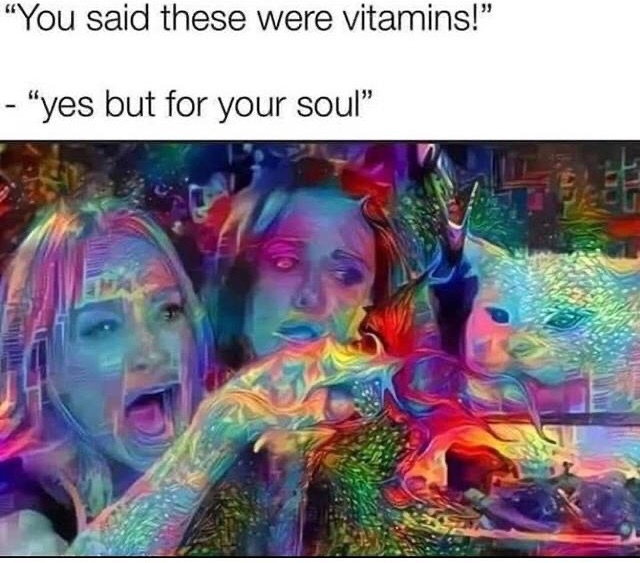January 15th 2021
Dear Blog, it’s been a while. How are you? Oh, you're upset I haven’t done this in a while? Better late than never though, right?
The psychedelic culture is associated to the 60s, for good reason, it was really just a decade of it being used and seen everywhere. I am learning about the Summer of Love and how there is more to the psychedelic culture than just the music and shirts. It was about activism and, well, the drugs of course. The 50s was mostly recovery from WW2 and so the 60s was the love of their liberation and to spread the peace. Though WW2 was way over, there was the Vietnam war and the cold war with the Soviet Union that was going on and it makes sense that these people just wanted to spend their time getting high and spread love. Honestly though, what better way to do it than through music, right? It speaks to all people, you don’t really need to be proficient in the language but you can always appreciate the good music.
The 60s really had a guy advocating for drugs. Anyone who says the 60s wasn’t a wild party is lying. Timothy Leary really lived a crazy life. Listening to him talk about his past is weird, it sounds like something that only happens in movies. He advocated for drugs, got arrested, escaped prison with the help of a random "fan" and ran away, tell me that doesnt sound like something from the movies?
I learnt of two important designers today, Wes Wilson and Victor Moscoso. Wilson with his fluid typeface and Moscoso with the vivid contrasting colours, together creating the psychedelic look. I like this topic I chose, I’m learning more about the psychedelic scene and well, music. Seeing some artists, albums, songs I already know and listen to while also finding new ones AND learning more about design history? I really hit the jackpot with choosing this essay topic.
Wes Wilson, Otis Rush at the Fillmore (1967); Victor Moscoso, Rites of Spring/The Cloud, Neon Rose series #11 (1967)
Moscoso's colour scheme continued past the psychedelic 60s. Digital art is heavily inspired by it. Fractal art is an art form under digital art where computers generate art based off algorithms and calculations. It is essentially just psychedelic art on computers.
Psychedelic River by boywhoturnedtostone (2010);
Psychedelic Trip by Hydrolyphics (2007)
I spent half my day writing one solid paragraph about one topic which is only a little more than 200words but the things I know now that doesn’t go into the essay makes it all kind of worth it. The number of tabs and windows I had opened made me go nuts a little but the more I have open, the more "zoned in" I am and the more I learn.
A Draft:
Pop culture would not be pop culture without the existence of music and the music industry as well as art, individually, would not be what it is now without the explosion of psychedelic culture. As stated by Connikie and Kathy Elgin (2007), music is the roots of the famous psychedelic graphics in the 60s. Despite the 60’s being before the age of internet, visual representation was just as important in the music industry in the 60’s with creating album sleeves, posters, etc. Two of the most influential designers associated to this decade are Wes Wilson and Victor Moscoso (Kulenović, 2017). Wes Wilson, dubbed as the father of psychedelic posters, changed the typography world. Wilson invented and popularised the ‘Psychedelic font’ in where the letters look like they are moving (Network9, 2020). As stated in Muse by Clio (2020), Wilson was able to popularise the font as he was making concert posters for Bill Graham, famous German-American rock concert promoter, which is how the psychedelic graphics proceeded to affect the music industry. Victor Moscoso was one of the first academically trained and experienced designers who went into creating rock posters (Smithsonian American Art Museum, n.d.). While Wilson is known for his typographic work, Moscoso is known for his vibrant contrasting colours that allowed the feeling and look of movement and/or vibration on the poster (Bahr Gallery,n.d).
One of the most iconic psychedelic album sleeves is Cream’s ‘Disraeli Gears’ by Martin Sharp. This cover alone summarizes psychedelic art perfectly, the vivid bright opposing colours that create the feeling of movement and/or vibration, the organic form of typography and the combination of illustrations and photography.
Bibliography:
http://www.artnet.com/artists/martin-sharp/ (Artnet, n.d)
https://www.widewalls.ch/magazine/typography-history-art (Kulenović,
S., 2017)
https://network9.biz/how-the-psychedelic-60s-changed-design-forever/
(Network9, n.d.)
https://musebycl.io/design/how-wes-wilsons-psychedelic-concert-posters-steeped-past-soared-future#:~:text=He%20had%20been%20working%20as,Alfred%20Roller%20and%20warping%20it.
(Muse by Clio, 2020)
https://americanart.si.edu/artist/victor-moscoso-18206 (Smithsonian
American Art Museum, n.d.)
https://www.bahrgallery.com/artist-master/victor-moscoso
(Bahar Gallery, n.d.)
https://www.udiscovermusic.com/stories/best-psychedelic-albums/ (Milano, B., 2020)
Not Used:
https://www.zekagraphic.com/wes-wilson-psychedelic-poster-design-father/
https://www.billboard.com/photos/7661568/album-covers-psychedelic-trippy
https://www.domestika.org/en/blog/3654-10-great-psychedelic-album-covers-from-the-late-60s
https://www.brooklynvegan.com/best-psychedelic-rock-albums-summer-of-love-1967/
https://bieritz.wordpress.com/1960/01/24/psychedelic/
https://visualartsdepartment.wordpress.com/psychedelic-60s/
https://www.udiscovermusic.com/stories/best-psychedelic-albums/
https://inkbotdesign.com/graphic-designers-music-industry/
https://www.artsy.net/article/artsy-editorial-timothy-leary-artists-lsd
https://psychology.fas.harvard.edu/people/timothy-leary





Comments
Post a Comment